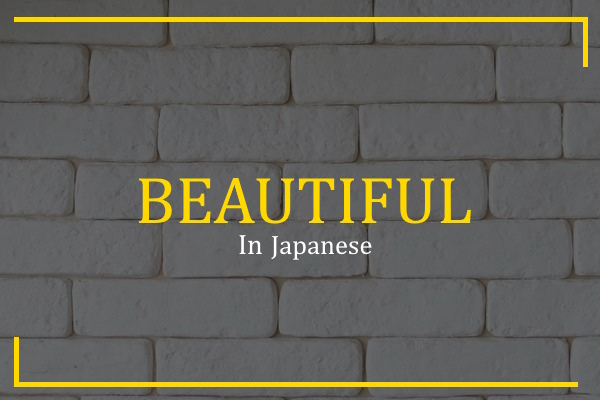Table of Contents
In Japan, there are two main terms: “kireina” and “utsukushii”. The two ways of saying “beautiful” in Japanese are not synonymous. To illustrate the difference, I will give example sentences in this blog post. Then, I will explain what makes the two sentences unique.
Beautiful in Japanese: 美しい (Utsukushī)
Defining and Deriving Meaning from “Kireina”
We will begin by defining and explaining the meaning of kireina which conveys a sense of beauty, neatness, and cleanliness. This meaning, however, is contingent on the situation and the context.
Native Japanese speakers normally use this word when describing something that looks beautiful. The conjugation “kirei” might be more famous and well-known than the others.
This conjugation is used quite often by native Japanese speakers as an interjection to say “beautiful!” in Japanese. With “kireina”, you can say “beautiful” in Japanese. In the way the following words are spelling out for beautiful in other languages.
Kyoto refers to a very famous city in Japan. We can use it in the example sentence as a noun.
Wa serves as a topic or case marker. Insert after the noun, “Kyoto”, in the example to make it the subject.
Basho is the Japanese word for ‘place’. It refers to places collectively. Learn more about the Japanese plural. ‘Kireina’ is the adjective preceding it in the example. In Japanese, “kireina basho” means “beautiful place”.
Desu adding formality to nouns, adjectives, and phrases with an auxiliary verb. This may have some connection to the Japanese desu form. Putting it after the noun phrase makes it sound more polite.
‘Basho’ is placed before it in this example to describe it. On a certain level, it is like using the adjective “beautiful” to describe its following noun. The complement of “kireina” should be conjugated according to the following rules.
How to Conjugate “Kireina” as a Complement
This is the new word used in the example.
Kirei is na-adjective “kireina” can be conjugated in this way. This is a conjugated form so that its following word is easier to understand. “Kireina” is another typical usage of the word, it has been conjugated here. The auxiliary verb, “desu”, can be omit in casual situations to make the adjective sound more polite.
kyoto wa kirei Kyoto is beautiful. We can compare the sentence structures much more easily with this less polite expression. “Kirei” is a conjugated na-adjective used in the same way that the English adjective “beautiful” is used. In this sense, “kireina” is also quite similar to “beautiful”. Additionally, to its use as an interjection, you can also use “kirei” alone to say “beautiful!” in Japanese. We can use “kirei” when describing Kyoto’s beauty in the following way.
The use of kirei is frequent in this way by native Japanese speakers. I believe this is an exclusive usage. There is a rarity to use “utsukushii” as a way to describe “beautiful.” Grammatically, however, it is quite possible to do so. Still, it sounds a little strange.
I have already explained how to use “kireina”. Nonetheless, you should remember that it has different meanings. According to the situation and context, it means ‘beautiful’, ‘clean’, or ‘neat’. Thus, one can also translate the above examples into English as “Kyoto is clean” or “Kyoto is neat”. The Japanese word ‘Kireina’ does not have a dedicated meaning for ‘beautiful’. Kireina and utsukushii differ in this respect.
The Second Option Is “Utsukushii”.
Define “utsukushii” and explain its meaning. This, then, is what “utsukushii” is all about. utsukushii is an adjective in Japanese meaning ‘beautiful.’ The grammatical definition of this word is different than that of “kireina”. They differ quite a bit from a grammatical perspective.
Furthermore, “utsukushii” is a dedicated word that signifies ‘beautiful’. It is impossible to describe something as “clean,” “neat,” etc. Consequently, the use of “utsukushii” in different situations from that of “kireina”. I will illustrate how to use “utsukuhii” through the examples below.
Using “Utsukushii” To Say “Beautiful” In Japanese
Clearly, this is not the same sentence as the one with “kireina” in it. In contrast to “kireina”, which describes Kyoto’s appearance, “utsukushii” describes both its outside and its inside. As a result, “utsukushii” is the best word to describe Kyoto’s spirit, its history, and something beyond its appearance. It has slightly more sophistication than “utsukushii”. Utsukushii can also serve as a complement to “kireina”.
When to Add “Utsukushii” To a Compliment
In this context, it is not necessary to conjugate “Utsukushii”. You can leave it in the position of complement. Because I explained above, we have a slightly more sophisticated impression from this sentence than we have from the one with “kireina”. The situation may make it sound somewhat cheesy. The Japanese phrase “Kyoto wa kirei” would sound more natural and appropriate in most situations.
Conclusion: Kireina vs Utsukushii
The explanation of Both “kireina” and “utsukushii” is very clear in this blog post. They differ as follows.
- “Kireina” means multiple words while “utsukushii” means “beautiful”.
- The term “kireina” emphasizes appearance, while “utsukushii” describes both appearance and inside.
- Typically, we can use “Kirei” to say “beautiful!, but “utsukushii” is seldom in this way.
- “Utsukushii” might sound rather cheesy depending on the context.

Arslan Hussain, founder of The Different Languages, is an experienced translator passionate about languages and cultures. Through his website, he shares his knowledge and love for different languages, making learning accessible and enjoyable.

